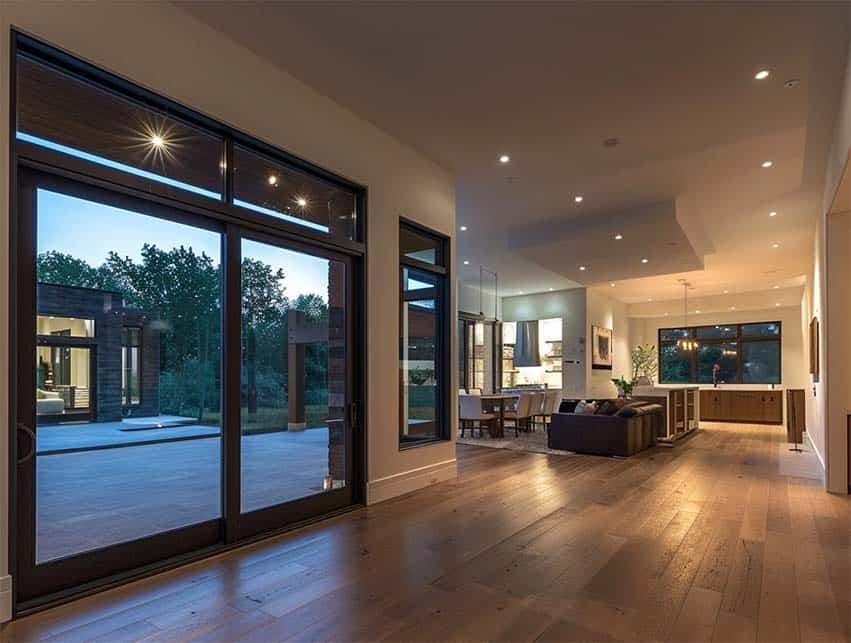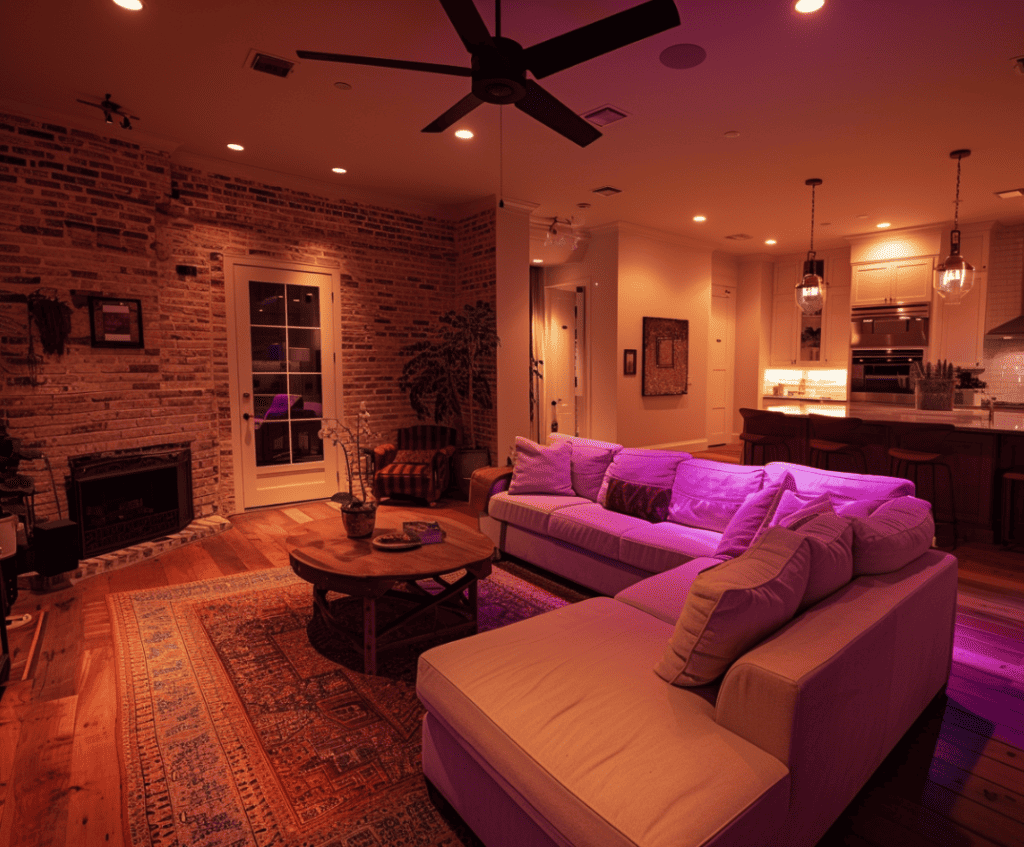Bathroom Electrical Remodel in San Antonio: Implementing It

How far could we push smart home automation in an electrical remodel project?
As electricians in San Antonio, we carry out full-fledged electrical remodels in homes and apartments. Whether it is a kitchen, a bathroom, or a living room, most remodels are “routine” jobs for experienced electricians. We simply need to analyze carefully the project scope and its price tag, and implement it with excellent methods and genuine care for our clients.
Some of the remodel jobs are more challenging however. In some cases, it is our responsibility to come up with a plan based on just a general overview of what the homeowners want to achieve. They don’t quite have the full vision; they need us to help fleshing it out.
Sometimes homeowners want to make their home “smarter” with the integration of Internet of Things technology (IoT). This is a more edgy challenge. Though an increasing number of manufacturers bring new IoT-embedded products to the market, the technology is still largely in its infancy.
Our role then starts with working in tight collaboration with the architect or the GC to help the homeowners define what level of automation they wish to have. Then we source out the components of the project. The GC or architect presents the owners with options. As the electrical contractor, All Star Electric San Antonio finalizes the scope and cost of the electrical remodel project. We always want to make sure the owners are not overdriving their headlights.
The challenge
Let’s say the project consists in doing the electrical remodel of a large master bathroom in a single-family home. Our mission is to integrate the latest lighting technologies and Internet of Things (IoT). We will also rewire all systems in full compliance with applicable codes.
The installation of the fixtures is the job of the general contractor and the plumber.
The architect has presented a layout that includes:
- A long vanity counter with 2 large sinks facing a large rectangular mirror.
- A large glass-encased shower area, lit up from above
- A large standalone bathtub with massage jets
- Recessed LED lights in the tray ceiling
- Some additional electronics: hardware with LEDs, a flat screen TV facing the tub
Vanity mirror: Selection and installation
“Smart” mirrors, embedding touch buttons at the surface of the glass, are not common place just yet. They still are high-end fixtures with limited functions:
- Dimmable LED lighting to project a direct light on the face. This type of neutral light helps with make-up and beauty care routine.
- Light temperature selector (in Kelvin) to “set the mood” in the bathroom.
- Defogger to avoid having to use fog-free spray after a long soak in a hot tub.
- Internal LED lighting if the vanity mirror doubles up as a medicine cabinet.
With the progress of sensors, some technologists predict that vanity mirrors will soon be able to perform a skin surface diagnostic. These systems could advise users as to what exfoliant, skin clarifier, gel, and make-up to apply considering the state of their skin and the weather conditions that day.
We are not yet there however! For this electric remodel challenge we would have to rely on what is currently on offer on the market.
ExBrite, an importer of high-end bathroom fixtures, offers 2 versions of smart vanity mirrors with touch surface controls. On the photo on the left, a large one-piece vanity mirror (60×36). On the right, a slightly smaller mirror with 2 panels opening on a medicine cabinet.

The model on the left is backlit with LED strips. This creates an ambiance halo, adding an extra touch of modernity to the bathroom. We could install an LED strip around the model on the right, but unlike the other model, the dimmer switch wouldn’t be integrated in the glass.
Installation
The electrical installation process for this vanity mirror is straightforward. The manufacturer has embedded all the controls (touch buttons and electronic circuitry) in the mirror itself. We would just need to pull wires to the location above the vanity, install an IP-rated junction box and connect the mirror with proper grounding.
Motion sensors
Additionally, we could install a motion detection sensor at the entrance of the master bath. It would trigger the mirror LED lights as people enter the room. In this case, we would connect the mirror to the sensor. A further degree of sophistication would consist in using close-proximity sensors. These would only trigger the vanity LEDs when the owners approach the vanity, not at the opening of the bathroom door.
Glass shower stall with light set-up and faucet control

In the course of this electrical remodel project, how would we plan the lighting set-up to compliment the high-end feel of a glass-enclosed shower stall?
What could be the role of the IoT? And what would be the risks of installing electronic equipment in the wet environment of a shower enclosure?
There are 3 main functions in a shower enclosure that homeowners can control via remote:
- The faucet: Start and stop, increase and decrease of pressure, water temperature.
- The lighting: Overhead LED lighting, or LED strips (in a cove ceiling) or alongside the glass enclosure.
- The ambiance: Voice-activated sound system
Controlling the faucet
U.S. manufacturer Moen offers a shower controller that can be installed on the wall of the shower, inside the enclosure. and will control all the functions of the faucet and showerhead in association with a special shower valve.
Connected via WiFi, the shower controller activates and stops using the manufacturer’s app, or Alexa, Siri, and Google Assistant. The control commands the shower valve to open and close to reach the set temperature. Definitely a good addition in a bathroom electrical remodel project pushing the envelope of home automation.

Moen is not the only manufacturer to propose this type of system. Theirs is not very expensive in the context of this project.
They also propose another model of this controller that will work for multiple showerheads:

This requires a fairly sophisticated installation process. We have to replace the shower valve, and flush-mount the controller on the finished wall. We need to seal it to keep it waterproof.
Choosing the lighting system
There is no shortage of lighting systems that can be installed in the vicinity of a shower enclosure.
- Flush-mount and recessed LED lights
- LED strip lights hidden in a cove ceiling or vertically alongside the glass enclosure
- LED embedded into a overhead rain showerhead
Only a licensed electrician can install LED strips and bulbs in wet environments, and all lighting devices must receive an IP rating for wet environments. A bathroom electrical remodel project is NOT a test bench for DIY skills.
According to the NEC
Chapter 4 Equipment for General Use Article 410 Luminaires, Lampholders, and Lamps II. Luminaire Locations 410.10 Luminaires in Specific Locations. (D) Bathtub and Shower Areas. No parts of cord-connected luminaires, chain-, cable-, or cord-suspended luminaires, lighting track, pendants, or ceiling-suspended (paddle) fans shall be located within a zone measured 900 mm (3 ft) horizontally and 2.5 m (8 ft) vertically from the top of the bathtub rim or shower stall threshold. This zone is all encompassing and includes the space directly over the tub or shower stall. Luminaires located within the actual outside dimension of the bathtub or shower to a height of 2.5 m (8 ft) vertically from the top of the bathtub rim or shower threshold shall be marked for damp locations, or marked for wet locations where subject to shower spray.
Rain shower head with LED
U.S. manufacturer Fontana Showers offers an interesting rain shower head with color-changing LED. The LEDs are directly embedded into the showerhead which is controlled by a special-purpose remote or by phone app. Unfortunately, we couldn’t pair this system with the Moen faucet control system.

Note: Only a licensed plumber and a licensed electrician can install this type of showerhead.
Using LED strip lights on the ceiling and on fixtures
There is no denying that LED strips do a wonderful job at creating accent lighting. Mounted hidden in a cove ceiling, or under an overhang, they create a diffuse, intimate light that sets the mood in any room. In our bathroom electrical remodel project, they will find a natural place above the shower stall, all around the main vanity mirror if they are not already on the fixture, and around the ceiling of the bathroom for general ambient lighting.

We definitely recommend color-changing LED strips, and all strips must be weatherproof, IP64 rated, and set on their own low-voltage circuit. Their installation is pretty straightforward. These color changing strips can be controlled by a special-purpose remote, by app, and sometimes by a hardwired rotating knob looking like a dimmer switch.
Sound ambiance
Installing a sound system inside a bathroom is definitely 100% green light in this electrical remodel project. The architect’s layout features a flat screen OLED TV on the wall, at the end of the bathtub. We will add 4 mini-speakers on the 4 corners of the bathroom, and will hook up both the TV and a hidden WiFi router to connect with the owners preferred music apps.
The route will be on its own circuit to minimize the noise and maximize the signal-to-sound ratio. The speakers will also be on their own circuit with insulated cables for the same reason.
With the profusion of audio apps available in the iTunes and Android libraries, there is no need for a dedicated screen.
We could also potentially sync the LED strip light to the sound system. Some strip lights apps can connect to a sound system.
Bathtub: Lynchpin of a bathroom electrical remodel
The favorite area of most people in a bathroom is the bathtub: it is synonymous with relaxing and taking time out. This is the reason why bathtub manufacturers deploy treasures of creativity to make tubs that look inviting, organically shaped or classically lined, and often loaded with massage jets.
Unless a bathtub has jets or an IoT control board, this would not be a fixture of much interest for the electrician in an electrical remodel project. But in this project, we are pushing the boundaries of technology integration, so we will assume the architect has selected a full tub with massage jets.
Our mission is to connect the jet controls to a control board which will also control the temperature of the bath. The owners would use a remote controller or a smart phone to start filling up the tub and stop the fill at the right level.

Bathtub with jets and integrated control
This model of standalone bathtub has massage jets. A small electronic board integrated into its structure controls it. You can sit the purple backlit function on the arm rest, on the far side. The installation requires bringing power under the floor, which will probably be destructive if the remodel does not include reflooring.
The controller also only controls the jets, not the faucet. So this is only a partial solution to the vision.

Touch controller
On the other hand, this WiFi-based bathtub controller offers multiple functions: water pump and air pump (start-stop fill, start-stop massage jets, control of water level), temperature, lighting, water pressure in shower handle, ozone disinfection. It even has a music controller (via bluetooth). You can associate it with a remote controller, and can also control it with a smart phone.
The device is waterproof (IP-rated) and all the function icons are activated by touch.
The photo shows the controller integrated in the armrest of the bathtub. But we could also install it on a wall nearby, together with the valve control system.
Connecting hardware with LED

Over the past few years, manufacturers of bathroom hardware have come out with sleek products integrating LED lights or imitating a LED light effect. We found 4 types of products:
- Faucets with temperature sensitive LED light
- Faucets with colored glass (no LED light)
- Faucets with battery-powered LED light
- Touchless faucets with LED light
All these fixtures have an aesthetic appeal, adding a futuristic touch to a sink or a tub when you want your electrical remodel project to achieve a cool modern look. They do not have the same price point however, as the technology involved and its likely longevity vary widely.
Faucets with temperature-sensitive LED light
The LED inside these faucets are powered by a small “turbine” (aerator) that rotates with the water flow to produce the power required to activate the LED and its temperature sensor. The temperature sensor controls the LED color as the temperature goes up and down. Typically, the LED will only display 3 to 7 light colors.
This passive device has the advantage of not requiring any wiring. It can be mounted by a plumber, even by the homeowners themselves. However, it is subject to the wear & tear of the small plastic aerator, and also to the roughness of the water. It will eventually fail to rotate to produce the power necessary to activate the LED and the temperature sensor. At this moment, you will need to replace the aerator, and it is not always possible, depending on the quality of the faucet.
Passive faucets with colored glass
These are very simple (albeit very sleek) devices that simply play on ambient light to appear colored. They don’t change color, they are not temperature sensitive and have no LED light. They are durable, cheap to install (DIY or by a plumber), and give a cool look to a sink or a bathtub. However, they don’t change color, and if your taste change and you grow tired of the color, you will have to replace the entire faucet.
Faucets with battery-powered LED light
These fixtures usually offer more flexibility in terms of aesthetics, as the LED lights can display a whole spectrum of light. A lithium battery activates the LED and needs replacement every 3-5 years, depending on the manufacturer. The LED may come associated with a temperature sensor that varies the color emitted by the LED, but it’s not necessarily the case. In some models, the owner controls the color via an app.
We see 3 main benefits to these fixtures: they don’t rely on an aerator to activate the LED and the sensor; they appeal to all tastes as the LED can change to any color; and they are not complicated to install: the battery casing is separate from the faucet itself, and requires minimal time to install.
Faucets with motion sensor, color LED, and direct wiring

These are more sophisticated devices, not often seen in the context of a residential bathroom electrical remodel. Motion-activated (or touchless) fixtures are now the standard in public places. They drastically reduce the risk of contamination and disease transmission inherent to any traditional faucet manually operated.
Their infrared motion detection sensors require constant power. The source of power can be DC, AC, or battery. IR sensors are not very power-hungry but since they are “always on” to detect motion, they will run down their battery faster than other types of faucets. AC- or DC-powered touchless faucets draw a very small amount of current from the mains, so they require the least amount of maintenance.
These touchless faucets are often equipped with temperature sensors that will flash an LED to warn users when the set temperature is too high. Depending on the model, they can display colors or not.
Their installation is fairly simple but it can require opening and closing sheetrock to hide the power source. As an electrical contractor, All Star Electric San Antonio can obviously take care of this task within the scope of an bathroom electrical remodel project.
Why select All Star Electric San Antonio for your electrical remodel project?
As licensed electricians in San Antonio, All Star Electric has been operating in our city for almost 30 years. This says a lot about the quality of our electrical installation and repair services. As a full-service electrical contractor, we have kept our A+ rating at the BBB San Antonio with no complaint to our name since we became members of the BBB. Our Google reviews shows that clients really like the quality of our services, with a solid rating of 4.5 stars.
Having almost 30 years of experience as an electrical contractor, we are capable of handling absolutely all electrical remodel projects, from simple hallway re-wiring and lighting, to full-size kitchen and bathroom remodels. We work with your architect and and general contractor, making sure that we complete our mission on time for their teams to fulfill their obligations.
Electrical remodel projects require a thorough analysis phase. During this phase, you can count on us to help you flesh out your project and finding ways to make your vision become a reality. If you work with an architect or a general contractor, we will support their effort to achieve your vision in a timely manner, and on-budget.
Call us at (210) 391-0274 to discuss what you have in mind, and bring our knowledge and experience at your service.
Additional resources:
San Antonio Home Automation & Smart System Installation
EV Chargers: The Next Step-up in San Antonio Smart Homes




























